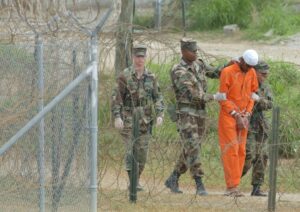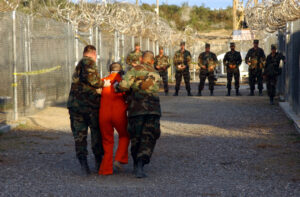Beyond Islamic State: The Folly of World War IV
Arguing that no alternative exists to open-ended war represents not hard-nosed realism, but the abdication of statecraft. The real problem is war itself and the conviction that only through war can America remain America. Jirka Matousek / CC BY 2.0
1
2
3
4
Jirka Matousek / CC BY 2.0
1
2
3
4
What Would World War IV Cost?
During World War III (aka the Cold War), the Pentagon maintained a force structure ostensibly adequate to the simultaneous prosecution of two and a half wars. This meant having the wherewithal to defend Europe and the Pacific from communist aggression while still leaving something for the unexpected. World War IV campaigns are unlikely to entail anything on the scale of the Warsaw Pact attacking Western Europe or North Korea invading the South. Still, the range of plausible scenarios will require that U.S. forces be able to take on militant organizations C and D even while guarding against the resurgence of organizations A and B in altogether different geographic locations.
Even though Washington may try whenever possible to avoid large-scale ground combat, relying on air power (including drones) and elite Special Operations forces to do the actual killing, post-conflict pacification promises to be a manpower intensive activity. Certainly, this ranks as one of the most obvious lessons to emerge from World War IV’s preliminary phases: when the initial fight ends, the real work begins.
U.S. forces committed to asserting control over Iraq after the invasion of 2003 topped out at roughly 180,000. In Afghanistan, during the Obama presidency, the presence peaked at 110,000. In a historical context, these are not especially large numbers. At the height of the Vietnam War, for example, U.S. troop strength in Southeast Asia exceeded 500,000.
In hindsight, the Army general who, before the invasion of 2003, publicly suggested that pacifying postwar Iraq would require “several hundred thousand troops” had it right. A similar estimate applies to Afghanistan. In other words, those two occupations together could easily have absorbed 600,000 to 800,000 troops on an ongoing basis. Given the Pentagon’s standard three-to-one rotation policy, which assumes that for every unit in-country, a second is just back, and a third is preparing to deploy, you’re talking about a minimum requirement of between 1.8 and 2.4 million troops to sustain just two medium-sized campaigns — a figure that wouldn’t include some number of additional troops kept in reserve for the unexpected.
In other words, waging World War IV would require at least a five-fold increase in the current size of the U.S. Army — and not as an emergency measure but a permanent one. Such numbers may appear large, but as Cohen would be the first to point out, they are actually modest when compared to previous world wars. In 1968, in the middle of World War III, the Army had more than 1.5 million active duty soldiers on its rolls — this at a time when the total American population was less than two-thirds what it is today and when gender discrimination largely excluded women from military service. If it chose to do so, the United States today could easily field an army of two million or more soldiers.
Whether it could also retain the current model of an all-volunteer force is another matter. Recruiters would certainly face considerable challenges, even if Congress enhanced the material inducements for service, which since 9/11 have already included a succession of generous increases in military pay. A loosening of immigration policy, granting a few hundred thousand foreigners citizenship in return for successfully completing a term of enlistment might help. In all likelihood, however, as with all three previous world wars, waging World War IV would oblige the United States to revive the draft, a prospect as likely to be well-received as a flood of brown and black immigrant enlistees. In short, going all out to create the forces needed to win World War IV would confront Americans with uncomfortable choices.
The budgetary implications of expanding U.S. forces while conducting a perpetual round of what the Pentagon calls “overseas contingency operations” would also loom large. Precisely how much money an essentially global conflict projected to extend well into the latter half of the century would require is difficult to gauge. As a starting point, given the increased number of active duty forces, tripling the present Defense Department budget of more than $600 billion might serve as a reasonable guess.
At first glance, $1.8 trillion annually is a stupefyingly large figure. To make it somewhat more palatable, a proponent of World War IV might put that number in historical perspective. During the first phases of World War III, for example, the United States routinely allocated 10% or more of total gross domestic product (GDP) for national security. With that GDP today exceeding $17 trillion, apportioning 10% to the Pentagon would give those charged with managing World War IV a nice sum to work with and no doubt to build upon.
Of course, that money would have to come from somewhere. For several years during the last decade, sustaining wars in Iraq and Afghanistan pushed the federal deficit above a trillion dollars. As one consequence, the total national debt now exceeds annual GDP, having tripled since 9/11. How much additional debt the United States can accrue without doing permanent damage to the economy is a question of more than academic interest.
To avoid having World War IV produce an endless string of unacceptably large deficits, ratcheting up military spending would undoubtedly require either substantial tax increases or significant cuts in non-military spending, including big-ticket programs like Medicare and social security — precisely those, that is, which members of the middle class hold most dear.
In other words, funding World War IV while maintaining a semblance of fiscal responsibility would entail the kind of trade-offs that political leaders are loathe to make. Today, neither party appears up to taking on such challenges. That the demands of waging protracted war will persuade them to rise above their partisan differences seems unlikely. It sure hasn’t so far.
The Folly of World War IV
In his essay, Cohen writes, “we need to stop the circumlocutions.” Of those who would bear the direct burden of his world war, he says, “we must start telling them the truth.” He’s right, even if he himself is largely silent about what the conduct of World War IV is likely to exact from the average citizen.
As the United States enters a presidential election year, plain talk about the prospects of our ongoing military engagement in the Islamic world should be the order of the day. The pretense that either dropping a few more bombs or invading one or two more countries will yield a conclusive outcome amounts to more than an evasion. It is an outright lie.
Your support matters…Independent journalism is under threat and overshadowed by heavily funded mainstream media.
You can help level the playing field. Become a member.
Your tax-deductible contribution keeps us digging beneath the headlines to give you thought-provoking, investigative reporting and analysis that unearths what's really happening- without compromise.
Give today to support our courageous, independent journalists.






You need to be a supporter to comment.
There are currently no responses to this article.
Be the first to respond.